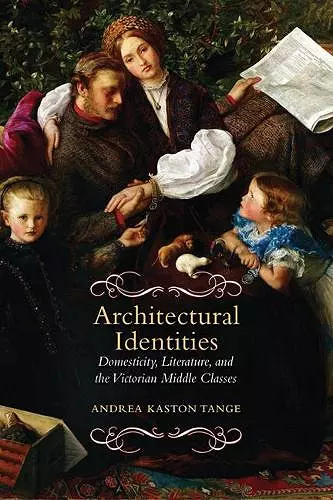Architectural Identities
Domesticity, Literature and the Victorian Middle Classes
Format:Hardback
Publisher:University of Toronto Press
Published:1st Oct '10
Currently unavailable, and unfortunately no date known when it will be back

'In Architectural Identities, Andrea Kaston Tange has brought together a splendid set of seemingly disparate materials related to domestic architecture in the Victorian era and shown, persuasively and with brilliant effect, how they inform each other. Beautifully written and original, this study is a pleasure to read.' -- Devoney Looser, Department of English, University of Missouri-Columbia 'Architectural Identities effectively examines the relationship between domestic ideology and household space in both theory and practice. With skilful readings, copious research, and polished prose, Andrea Kaston Tange reaches new and fascinating conclusions about domesticity, marriage, and family life in the Victorian era.' -- Teresa Mangum, Department of English, University of Iowa
Including analyses of both canonical and lesser-known Victorian authors, Architectural Identities connects the physical construction of the home with the symbolic construction of middle-class identities.
Architectural Identities links Victorian constructions of middle-class identity with domestic architecture. In close readings of a wide range of texts, including fiction, autobiography, housekeeping manuals, architectural guides and floor plans, Andrea Kaston Tange argues that the tensions at the root of middle-class self-definition were built into the very homes that people occupied.
Individual chapters examine the essential identities associated with particular domestic spaces, such as the dining room and masculinity, the drawing room and femininity, and the nursery and childhood. Autobiographical materials by Frances Hodgson Burnett, Thomas and Jane Welsh Carlyle, Elizabeth Gaskell, and Linley and Marion Sambourne offer useful counterpoints to the evidence assembled from fiction, demonstrating how and where members of the middle classes remodelled the boundaries of social categories to suit their particular needs. Including analyses of both canonical and lesser-known Victorian authors, Architectural Identities connects the physical construction of the home with the symbolic construction of middle-class identities.
‘Painstakingly researched and persuasively argued, Tange's book seamlessly interweaves diverse sources and texts. Reconfiguring the brick-and-mortar edifice of the Victorian home as a fluid site of dynamic interactions, it sheds new light on Victorian domestic space and Victorian domestic fiction as well as on the provocative and subtle interactions between them. ’ -- Elizabeth Gargano, Review19: Online Journal 2011-10-28
‘Fascinating book…Architectural Identities is a book that should rightfully stand as a landmark in Victorian scholarship… In the owrds of Henry Wadsworth Longfellow, Tange has raised a “beautiful, entire, and clean” structure. Victorians scholars may dwell here secure in the knowledge that they will attain vistas here that had hitherto been covered by abstractions.’ -- Shale Preston * Victorian Periodicals; Winter 2011 *
- Winner of Outstanding Academic Title awarded by CHOICE Magazine 2012 (United States)
ISBN: 9781442641136
Dimensions: 237mm x 162mm x 29mm
Weight: 680g
336 pages